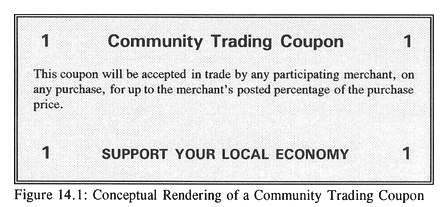"Change occurs when there is a confluence of both changing values and economic necessity, not before."
-- John Naisbitt [99]
Bootstrapping The Local Economy
Everybody knows how discount coupons work -- 10% off, 20% off, 2-for-1, $1 off, etc. -- and every business operator knows that coupons can boost sales. But, even though a well-designed coupon campaign can stimulate business, it is not without its own costs. First, there is the cost of designing the coupon, then the cost of getting it into the hands of the potential customer, and finally, the lost revenue of the discount itself. The hope, of course, is that these costs will be more than made up for by the increased business which the coupons generate, but that may or may not result. As competing businesses adopt the coupon strategy, its effectiveness tends to diminish and profit margins may be permanently reduced for everyone.
One of the primary factors which makes the use of coupons and other gimmicks necessary, even more than the local competitive climate, is the general deficiency of money in circulation. This is especially true during periods of so-called "recession." But even under "normal" economic conditions, the customers of a particular type of business may have their buying potential restricted because their disposable income is not keeping pace with inflation. This deficiency of money in circulation derives generally, not from any inadequacy in the resources or productive capacity of the local economy, but rather from the workings of remote agencies, including The Federal Reserve Board, the Federal government, large commercial banks, and the central banks of other countries. These agencies, which are closely inter-linked and often act in consort, hold tight control over the media of exchange, and by their policies, which they pursue in their own interests, can stimulate or strangle both national and local economies.
As we have pointed out, however, there are local initiatives which can be used to effectively preserve the integrity of local economies in the face of adverse external conditions; initiatives which are private, voluntary, and do not depend upon government-granted privileges. One such strategy involves the issuance of coupons. There is a way for local businesses to get all of the benefits of a coupon campaign without having to incur most of the usual costs. They can do this if they will cooperate as well as compete.
Suppose a group of businesses decided to cooperate in jointly issuing coupons which they all would agree to accept, not only from the public, but from each other, as well. Let's say that each business would agree to accept payment partly in cash and partly in coupons, with each business itself deciding what percentage of the price to accept in coupons. This percentage could be based on the costs and value-added of the particular business (subject to some minimum percentage), allowing cash costs to be met, while all or part of the value added by a business would be received in coupon form. The percentage of the purchase price which each business is willing to accept in Coupons would be advertised and posted on the premises. As an example, Primo Pizzeria might advertise, "We accept Community Trading Coupons for up to 30% of the purchase price on any pizza." Of course, those accepting a higher percentage of payment in coupons would probably attract more of the available business than those accepting a lower percentage. Such a coupon might look like the one pictured in Figure 14.1.

|
Now how exactly would these coupons be issued? This is the key question. It must be done properly to keep the coupons circulating and in demand. The primary factor here is the nature of the agreement among the cooperating merchants. It must be carefully formulated, clearly stated, and adhered to. Ideally, it should be enforced, not by any outside authority or by resort to the legal system, but by the parties to the agreement themselves. Given a well-developed agreement, the opportunity for continued participation should by itself be adequate incentive for adhering to its terms.
Here's one way it could work. The cooperative group could issue standardized, pre-printed coupon blanks to each member business, in any amount desired, up to the equivalent of 2 month's potential average coupon receipts from sales. Thus, a business having average monthly sales of $20,000, which agrees to accept 20% of payment in coupons, could be issued up to $8,000 worth of coupon blanks:
- $20,000 monthly sales x 2 months x 20% payment in coupons = $8,000.
Similarly, a business having average monthly sales of $40,000, which agrees to accept 50% of payment in coupons, could be issued up to $40,000 worth of coupon blanks:
- $40,000 monthly sales x 2 months x 50% payment in coupons = $40,000.
The recipient business could then "spend" these coupons on purchases it makes from any other member businesses. It would, by accepting the blank coupons from the cooperative, obligate itself to redeem, i.e. give back to the cooperative, an equal amount of coupons over some period of time.
If the coupons have a limited life, this would force their redemption to take place within some finite time period. Of course, any business which is a member in good standing could be issued new coupons for the old ones which it redeemed, maintaining the circulation of coupons generally. Members would also agree that, if and when they wish to withdraw from the cooperative, they would turn over the same amount of coupons they originally received, and make up any deficiency using official currency. Some coupons will inevitably be lost or fail to be redeemed by the expiration date. This amount can be credited to an "insurance and public benefit fund" which would be used to cover losses due to bankruptcy or default of some members. Any accumulated amount, over and above that needed for prudent insurance of losses, could be used to support the cooperative itself or be donated to local non-profit community-improvement organizations. The cooperative might also impose certain levies upon its members for these purposes.
A coupon would first enter circulation when a member "spends" it on a purchase. The spender would validate the coupon by signing and/or stamping it, and dating it (or dates could be pre-printed on the coupons). The recipient of the coupon could then, in turn, spend it on purchases from any other member of the cooperative, or anyone else willing to accept it in payment. Thus, the coupons could circulate as a supplemental medium of exchange up to their expiration date, the holder being assured that they would be accepted, at least, by all the members of the cooperative. This process is depicted in Figure 14.2.

|
The benefits to the member businesses should be apparent. Instead of competing with each other for whatever scarce official money might be circulating within the community, they would be cooperating to supplement that money with a local exchange medium, making it possible to transact a greater amount of trade. Since the coupons would have value only for purchases made locally, they would remain in the community instead of being used to buy from outside the community, tending to make it more self-reliant and less dependent upon imports from outside. Since anyone would be allowed to spend them, their use would benefit not only the members of the cooperative but everyone in the community. As the member businesses begin to thrive, others will be inclined to accept the coupons also, causing the amount in circulation to increase, and giving the community greater control over its own economic life.